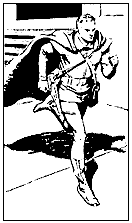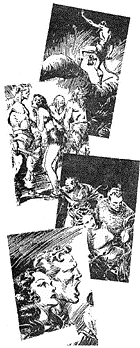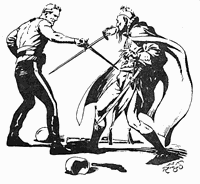
|
|
|
ZANIMLJIVO |
![[Pobijedi i osvoji nagradu!]](adds/ad-prize.gif) |


Taken from "Flash Gordon, The SF Comic Strip of All Time", by Hrvoje Prčić
 saac Asimov,
a legend amongst science fiction writers, once explained the three basic themes found in
this - perhaps the most popular in the world - genre, using the invention of an amazing
device, a horseless chariot named 'automobile', as an example. According to Asimov,
there are three basic approaches to this invention, different although at times
intersecting. saac Asimov,
a legend amongst science fiction writers, once explained the three basic themes found in
this - perhaps the most popular in the world - genre, using the invention of an amazing
device, a horseless chariot named 'automobile', as an example. According to Asimov,
there are three basic approaches to this invention, different although at times
intersecting.
|
 Flash Gordon, by Alexander Raymond |
The first is the scientific, fantastic,
predictive, educational: the writer describes, mostly in technical
jargon befitting a proffesor-inventor, this technological wonder,
explains the way it works, its principles, and sophisticatedness,
and shows its design, topping his depiction off with a practical demonstration
of the invention's incredible features. The latter means taking it
for a ride down a safe track, at the awesome speed of 20 Mph. The second is exemplified by a writer, who takes the high read to a problem, analyzing it through social, psychological, and philosophical issues, incidentally making a mention of all the unimportant technical features, and observing the impact this "monster" makes upon human society with its incredible speed of 20 Mph, its air polluting effect, the changes it induces in man's relations to time and space, the social stratification it brings about, etc. |
|
The third SF author is more inclined toward having fun, and writes so-called
adventure science fiction: a weird scientist invents an incredible automotive vehicle, but
it gets stolen by gangsters who also take the professor's beautiful daughter as a hostage.
A young, handsome, strong assistant rushes after them in another car at the wondrous speed
of 20 Mph, catching up with them after a breakneck chase, taking care of all the bad guys,
and saving the beauty. The two of them then live happily and cheerfully ever after. |
| The most typical instance of this kind in
SF are space-operas: space adventures in which the most incredible
vehicles wildly chase each other in the most impossible worlds, where
blasters shoot, seductive beauties sparkle ... the most famous representative
of this sub-genre being undoubtely FLASH GORDON. |
| Alexander Gillespie Raymond was born on October
2, 1909 in New Rochelle, state of New York. As a twelve-year old he
was left fatherless, so he was forced to take up sports with all his
might and thus win a scholarship to Iona Preparatory School and the
University of Notre Dame. After graduation, he became a stockmarket clerk. The stockmarket crash of 1929 crashed his stockmarket career as well, so he enrolled in Grand Central School of Art, fighting his way to the comic strip throne. His first works were assistant ones, on comics such as 'Tillie the Toiler', 'Blondie' (the most popular comic in the world at that time), and 'Tim Tyler's Luck', after which he gained permanent employement with the King Features Syndicate. Incindentally, his comic role models were works by well-known artists, Matt Clark and Charles Dan Gibson. |

Flash Gordon |
In January 7, 1934, Alex Raymond introduced the world
to a new hero - Flash Gordon, a polo player and Yale graduate. And
legend was born! The idea for this timeless strip-series was given
by journalist Joe Conolly, based on the novel 'When the Worlds Collide'
by Philip Wylie and Edwin Balmer. The unbeleiveable, picturesque, wondrous, kosmic, imaginative, opulent, fantastic adventures of this space-opera hero do not need special destription, as his comics have been published many a time (but rarely in Croatian!), from his first flight to planet Mongo, to his most recent adventures as a member of the space police. Strips, tables, entire episodes and books presented the almighty blond beauty Gordon, his genious friend Hans Zarkov, and the beautiful maiden Dale Arden to the public. And immediately we notice archetypes: the intelligent, able American graduate educated in the famous Anglosaxon science-and-sports regime; the mad scientist of German and Russian descent; the gentle and feminine, faithful and devoted maiden, with a French surname; the chief enemy belongs to the yellow, slanteyed race; technological futurism and fantastic landscapes as scenery. |
| Of course, in fifty-odd years of publication 'Flash
Gordon' went through numerous changes, but it was retained its
archetypal, clichee, romantic, male chauvinistic and adventureous
approach to this very day. Raymond began to draw Flash in the Sunday paper in his typical hyperrealistic way, full of dynamism, with an eye for details. His first drawings consisted of thick, greasy lines, long strokes, blackened and curved planes. Later on, he changed his style toward superb preciseness, which bestowed the glory of one of the greatest comic strip artists in history upon him. |

|
He paid exceptional attention to the human form, which always dominated the frame, leaving
an impression of extraordinary vitality, glorifying the beauty and grace of movements of
the body, of intercourse between a man and a woman. Raymond was an incurable romantic and
aesthete. He was also fond of experimenting. He developed and introduced the "feathering"
technique (defining or softening a contour with a series of fine lines). He introduced
square text baloons as well, followed by no-baloon dialogues ... |
 Alexander Raymond |
After Raymond, his assistant Austin Briggs
took up drawing Flash; at first he only did the daily sequels, but
later on, when Alex went to war, he took over the Sunday ones as well.
Briggs continued in the line of his predecessor in an excellent manner,
completely retaining his style (although with less perfection). However,
Briggs soon left comics and devoted himself to illustration work (which
made him quite wealthy). After demobilization, Raymond never went
back to his hero again. He worked on other comics ('Rip Kirby'),
until an early death caught up with him in a car accident (on September
6, 1956). |
| 'Flash Gordon' was continued after Briggs
by Emanuel Mac Raboy (1948-67), and Dan Barry, who was helped by Ric
Estrada, Frank Frazetta, Ray Kenkel, and especially by Al Williamson. 'Flash Gordon' is still one of the most-read world comics today. No decline in its popularity has been percieved, although its SF image is strictly classical, unlike that of the numerous and well-known modern creations. |

|
Copyright © 1995-2000 Zvonimir Tošić. All rights reserved. Hosted by cro.net |